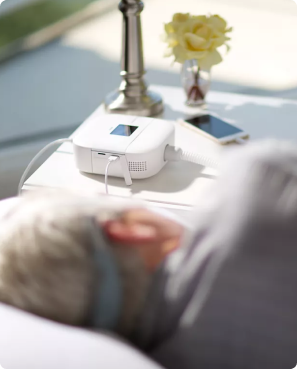Introducing the Airvo 2
If you are undergoing respiratory therapy for asthma, chronic bronchitis or emphysema, or any other chronic obstructive pulmonary disease
The newer HFNC systems like the Airvo 2 remedy these complications by removing unwanted carbon dioxide from the respiratory gas that the patient inhales. In turn, COPD patients are less likely to suffer from fatigue, memory loss, labored breathing and other symptoms resulting from therapy using the traditional low-flow systems. Plus, the Airvo 2 is simple enough to use at home. In fact, you can download the Airvo 2 simulator app to learn to use it in no time.
What is the Airvo 2?
Put simply, the Airvo 2 is a humidifier that comfortably delivers high flows of air and oxygen to patients undergoing respiratory therapies for COPD. As a result, the Airvo 2 features the Optiflow™ nasal interface cannula that has different types of attachments, or parts and accessories, that increase the versatility of the Airvo 2. In addition to attachments for adults and children, there is also a tracheostomy interface adapter. Unlike traditional nasal cannula, the Optiflow™ interface features a heat bearing tube and patient interface that makes for relaxing beside treatment at home.


How does the Airvo 2 work?
The Airvo 2 works by pulling oxygen and air in through vents that will ultimately form respiratory gases the patient will inhale. As the gases flow through the sensors inside of the Airvo 2, the motor of the unit pushes the mixture of air and oxygen through a series of sensors into a water chamber. Next, the water levels in the chamber are maintained by a special float to ensure the water stays at a constant height. There is also a heater plate in the water chamber. This maintains water temperature. Finally, the respiratory gases are heated to a body temperature of 98.6°F or 37°C.
What is Passover Humidification?
This is what’s known as a heated passover humidification system. What this means is that the tiny vapors the Airvo 2 creates are microscopic. Therefore, they are easier for the patient to inhale. Plus, the vapors are so small they cannot transfer bacteria or viruses. This makes for a clean and safe system. Hence, the Airvo 2 uses vapor instead of cold water droplets to greatly decrease the risk of infection.
As the water vapors are pushed through the heated breathing tube at the top of the Airvo 2, the respiratory gasses are heated again. Since COPD patients tend to experience an increase in mucus in their lungs, the reheating of the vapors within the Airvo 2 is a remedy for this by breaking up excess mucus within the patient’s airways. In turn, it helps the patient breath better.
Think of it this way: at room temperature, honey is sticky and thick. That is, it has a high viscosity. However, if you heat honey up and add water to it, the viscosity becomes much lower and it flows more like water. The mucus buildup within the airways of COPD patients is like honey: when warmed and watered down, it flows through the body more easily. In turn, the COPD patient breathes easier.
What Makes the Airvo2 Unique?
The Airvo 2 has heat sensors at the end of the breathing tube. These sensors maintain the temperature of the water vapors. As a result, the COPD patient comfortably receives the respiratory gasses. The beauty of this is that there are no external probes or wires, or any other gadgets required to measure the delivery temperature.
This means that the patient can eat, drink, and talk while wearing the nasal interface. Conventional low-flow symptoms were a burden in this regard, yet the Airvo 2 actually increases patient comfort and lowers the risk of noncompliance during therapy. Furthermore, the Airvo 2 is versatile and practical for home use.
AIRVO CLEANING AND DISINFECTION CHECKLIST
The AIRVO machine must cleaned and disinfected in between patient use per manufacturer guidelines. The following instructions will complete the reprocessing of the device ensuring infection control for multi-patient use.
Disinfection reprocessing should take place as soon as possible after use to minimize the risk of bacteria colonization.
Steps for Cleaning the Airvo
- Remove the water chamber, heated breathing tube and patient interface from the device and discard properly.
- Remove the discontinued AIRVO device from the patient’s room and return to the supply area.
- Wipe outside of the AIRVO machine with approved PDI/Sani-cloth avoiding all ports for breathing tubes or oxygen supply tubing connections. (Follow
all wet and drying times for the PDI/Sani-cloths being used.) - Attach red disinfection tube and turn device on. High level disinfection
cycle will run for fifty-five minutes until cycle is complete. - Store clean device appropriately in clean equipment storage area.
Airvo requirements for patient disposables. (Single Patient Use Only)
- Replace patient interface once every thirty (30) days. May be cleaned with mild soap and water weekly and air dried in between use
- Replace heated breathing tube once every sixty (60) days.
- Clean the water chamber: rinse and replace distilled or sterile water daily.
- Disinfect with 1-part vinegar, 2 parts water once weekly by soaking for 10 minutes and rinsing thoroughly.


